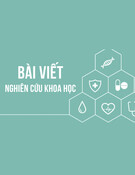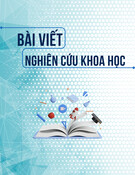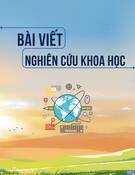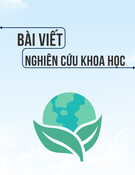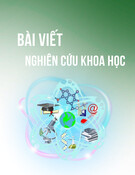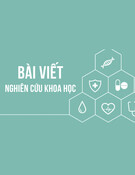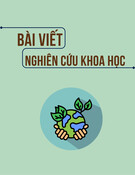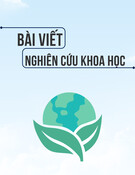
97
HNUE JOURNAL OF SCIENCE
Educational Sciences 2024, Volume 69, Issue 4, pp. 97-108
This paper is available online at https://hnuejs.edu.vn
DOI: 10.18173/2354-1075.2024-0167
APPLYING PROJECT-BASED LEARNING TO EDUCATE PRIMARY SCHOOL
STUDENTS ON ENVIRONMENTAL PROTECTION
Nguyen Diep Ngoc and Ngo Thi Kim Hoan*
Faculty of Education, Hanoi Metropolitan University, Hanoi city, Vietnam
*Corresponding author: Ngo Thi Kim Hoan, e-mail: ntkhoan@daihocthudo.edu.vn
Received August 6, 2024. Revised September 23, 2024. Accepted September 30, 2024.
Abstract. Environmental protection has become a global concern, making environmental
protection education vital at the primary school level. This education aims to
comprehensively develop students' competencies and qualities as outlined in the 2018
General Education Curriculum. Project-based learning is a teaching method where students
engage in complex tasks that seamlessly integrate theory and practice. Through high self-
reliance, students autonomously complete tasks, acquiring essential knowledge and skills by
solving problems linked to real-life contexts. Upon completing projects, students produce
outcomes that align with learning objectives or propose practical solutions to real-world
issues. This study employs document-based research methods closely linked to practical
teaching. The paper proposes a process for applying project-based learning to environmental
protection education for primary school students, based on relevant content, to meet the
requirements of the 2018 General Education Curriculum. This approach is designed to help
students complete tasks systematically and logically.
Keywords: environmental protection education, primary school students, project-based
learning process.
1. Introduction
Maria Montessori once shared a meaningful insight about the environment: a child who
deeply loves their surroundings and all living creatures, and who finds joy and enthusiasm in their
work, gives us hope for a new direction in humanity's development. This quote highlights the
significant impact the environment has on children, especially primary school students. Among
modern teaching trends, project-based learning (PBL) stands out as an advanced method that
places learners at the center, promoting active and self-directed learning. This approach was
pioneered by American educator and philosopher John Dewey (1859-1952), who championed the
idea of teaching through specific projects and practical problem-solving (Dewey, 1897). The
method was first implemented by Barrow, an American neurologist and professor at McMaster
University in Canada, in 1969. PBL is a student-centered teaching model that encourages students
to explore, apply the knowledge they have gained, and create their products through open-ended
assignments. Unlike traditional teaching models, PBL involves a complex pedagogy where
students acquire knowledge and develop skills by solving real-world problems, all under the
guidance of a teacher. This approach integrates closely with the curriculum, combining theory
and practice, and culminates in the creation of specific products (MOET, 2018; Dinh et al., 2019).
The core of project-based learning is that students gain essential knowledge and skills through
situational tasks that relate to real-world practice (the project assignment). Upon completing the

Nguyen ND* & Ngo TKH
98
project, students must produce a product that aligns with the learning objectives and has practical
applications. This approach not only deepens their understanding but also ensures that their
knowledge is practically applied.
PBL is an instructional model that organizes learning around projects. In PBL handbooks for
teachers, projects are defined as complex tasks centered on challenging questions or problems,
involving students in design, problem-solving, decision-making, or investigative activities. These
projects allow students to work relatively independently over extended periods and result in
realistic products or presentations (Jones et al., 1997; Thomas et al., 1999). Key characteristics
highlighted in the literature include authentic content and assessment, teacher facilitation rather
than direct instruction, clear educational goals (Moursund, 1999), cooperative learning, reflection,
and the integration of real-world skills (Diel et al., 1999). Smith (2018) characterized PBL as an
educational approach where students cultivate and apply skills by engaging in a long-term project
focused on deeply exploring a particular topic or question. This method introduces students to
new skills and allows them to refine those they have already started to learn. According to research
by Akseka and Haataien (2019), PBL effectively involves a wide range of participants, including
both teachers and students. PBL offers significant benefits by developing essential skills such as
teamwork, problem-solving, and innovation, while also broadening students' knowledge.
Moreover, PBL is seen as an effective instructional strategy for preparing students for higher
education, professional growth, and future challenges (Larmer et al., 2015). In the 2018 General
Education Curriculum, environmental protection education for primary school students is
delivered through various subjects and activities, including Moral education, Experiential
activities, Science (Grade 4), and History and Geography (Grades 4 and 5), etc. With a strong
foundation, students can engage in meaningful actions to protect the environment. Implementing
PBL, especially in environmental education, will help primary school students develop autonomy,
self-directed learning, communication and collaboration skills, as well as problem-solving and
creativity. Additionally, it will foster five key qualities: patriotism, compassion, honesty,
responsibility, and diligence.
The primary challenge of implementing PBL lies in designing practical and feasible activities
that yield successful outcomes. Environmental protection education is a vital component of the
school curriculum, aimed at developing specific competencies in primary school students while
promoting their overall personal growth, in accordance with the objectives of the 2018 General
Education Curriculum. This approach positions primary school students at the center of the
learning process, encouraging them to adopt positive, proactive, and creative attitudes. It is
especially relevant for environmental protection education, as students can easily observe and
identify environmental issues in their daily lives such as climate change, water quality, air quality,
and the presence of waste or greenery in their classrooms. Through project assessments, teachers
can effectively gauge students’ engagement levels, their ability to apply knowledge to real-world
situations, and their problem-solving skills regarding environmental challenges. This paper
proposes a method for implementing PBL in environmental protection education for primary
school students. It is grounded in a study of relevant content and outlines a clear instructional
process that aligns with the requirements of the 2018 General Education Curriculum.
2. Content
2.1. Project-based learning in primary schools
2.1.1. Definition
PBL is a student-centered instructional approach based on three constructivist principles:
learning is context-specific, learners are actively engaged in the learning process, and they achieve
their goals through social interactions and sharing knowledge and understanding (Cocco, 2006).

Applying project-based learning to educate primary school students on environmental protection
99
As a distinct form of inquiry-based learning, PBL uses authentic questions and real-world
problems to provide a context for learning, leading to meaningful educational experiences
(Wurdinger et al., 2007; Al-Balushi & Al-Aamri, 2014). In this educational strategy, students gain
knowledge and skills by delving into and tackling a complex question, problem, or challenge over
an extended period. This approach enables students to actively engage with the material and
develop essential skills, including critical thinking, problem-solving, and teamwork (Hoang &
To, 2019).
In this research, PBL is recognized as an important and effective teaching method, well-
suited for the current education system oriented towards developing competencies. It applies to
various types of lessons and learning activities, particularly experiential activities in the 2018
General Education Curriculum (MOET, 2018). For primary school students, PBL is characterized
by the following features: (1) student-centered approach: students are at the center of project-
based teaching; (2) practical activities; (3) diverse learning activities; (4) combination of group
and individual work and (5) focus on outcomes: attention is paid to the project's outcomes. PBL
in primary schools integrates various teaching methods during the implementation process, such
as group discussions, presentations, observations, and problem-solving. To successfully
implement PBL, primary school teachers and students must have a solid understanding of active
teaching methods, their advantages, and limitations, to apply them flexibly throughout the
process. By leveraging these characteristics, PBL can effectively engage primary school students,
fostering their competencies and enhancing their learning experiences through practical, hands-
on projects.
2.1.2. Advantages and Limitations of Project-based learning in primary schools
Advantages:
- Learning occurs naturally, making the content more meaningful.
- Learning is driven by the need to solve practical problems, which stimulates active and
engaged learning, creating a favorable environment for students to practice and develop their
skills.
- PBL develops students' soft skills such as teamwork, time management, and critical
thinking.
- The curriculum is flexible, allowing for adaptation to different learning needs and
contexts.
Limitations:
- PBL requires significant time, technical resources, and financial investments.
- Teachers find it challenging to plan and manage student learning due to the lack of
textbooks or structured lesson plans.
- The uneven knowledge base of students makes it difficult to assess individual progress
accurately.
- Some students may not yet be ready for this new learning approach, especially those who
are accustomed to traditional methods (Dinh et al., 2019)
According to Kilpatrick (1918), a significant challenge teachers face is sustaining students'
interest in projects over an extended period while ensuring that the work remains purposeful. For
primary school students, PBL presents particular difficulties, especially for those in the early
grades, due to their developing cognitive abilities limited soft skills, and practical experience. In
contrast, students in the later grades of primary school can better leverage the strengths of PBL,
as they have matured cognitively and developed essential skills such as teamwork, which
enhances their capacity for exploration and discovery. Research and practical experiences in
organizing PBL linked to environmental protection education for primary school students reveal
several advantages and challenges. One of the main advantages of PBL is that it enables students

Nguyen ND* & Ngo TKH
100
to take ownership of their learning. They engage in practical activities and observe real-life
situations, moving beyond reliance on textbooks and illustrations. Through projects focused on
environmental education, students develop crucial skills such as communication, teamwork,
critical thinking, and problem-solving in real-world contexts. This hands-on approach not only
enhances their motivation to learn but also fosters their ability to explore and create, particularly
in transforming knowledge into action. However, implementing PBL in primary education also
involves challenges. These include effectively managing time during project organization,
potential time losses, and the preparation of physical resources and environments. Additionally,
it is essential to ensure that the specific objectives of the curriculum are met throughout the various
stages of the project.
2.2. Environmental protection education through Project-based learning for
primary school students
The environment is understood as the collection of surrounding factors or external conditions
that interact directly or indirectly and influence the development and existence of living
organisms. According to Article 3 of the 2005 Law on Environmental Protection, “The environment
includes natural and artificial material factors surrounding humans, which impact human life,
production, existence, and development, as well as nature” (National Assembly, 2005).
Environmental protection education aims to help individuals and communities develop a
deep and sensitive understanding of the environment and its existing problems. This involves
mastering basic environmental concepts, being aware of the responsibility to protect the
environment, forming a sense of love for nature, and establishing relationships to improve and
protect the environment. It also includes developing negotiation and problem-solving skills,
mobilizing community participation in environmental protection, fostering a self-reliant spirit,
and taking appropriate action to address environmental issues.
Environmental protection education aims to comprehensively develop students' knowledge,
skills, life values, and environmental awareness. This process is crucial for helping students
recognize the importance of environmental protection from a young age, especially at the primary
school level, and it contributes to the sustainable development of ecosystems. In primary schools,
environmental protection education is integrated into various subjects through multiple methods,
including full, partial, and content-related integration. However, this integration often faces
several challenges. A survey conducted in several primary schools in Can Tho City has identified
these issues and proposed solutions to enhance students' awareness of environmental protection
(Trinh & Lu, 2022). PBL serves as an effective approach for teaching environmental education
to primary school students. It allows them to actively implement their personal or group ideas,
ensuring that the various steps in the project are seamlessly interconnected. In this context,
primary school teachers act as guides, facilitators, and supporters, assisting students from
brainstorming ideas to completing the final product. They also organize peer evaluations and help
students reflect on their experiences and lessons learned from practical work. Additionally,
subject teachers, such as those in Fine Arts, Music, and Physical Education, can collaborate with
homeroom teachers to integrate environmental protection education into diverse learning projects.
This collaboration provides students with enriching experiential learning opportunities, further
enhancing their understanding and commitment to environmental stewardship.
Based on the psychological and cognitive characteristics of primary school students,
environmental protection education can be effectively integrated into PBL in ways that align with
their developmental traits. For students in grades 1, 2, and 3, environmental protection projects
create opportunities for collaboration, idea sharing, and discussions about solutions to
environmental issues. These projects help young learners understand the impact of the
environment on their community and encourage them to engage in activities aimed at improving

Applying project-based learning to educate primary school students on environmental protection
101
it. At this age, students can distinguish between positive and negative behaviors and recognize
what actions are necessary to protect the environment. However, their shorter attention spans may
pose challenges for implementing large or long-term projects. In contrast, students in grades 4
and 5 exhibit more developed cognitive abilities and a heightened desire to explore the world
around them, making PBL particularly suitable for this age group. Environmental protection
projects at this level are practical and socially relevant, stimulating curiosity and creativity
through hands-on activities and experiences. These older students can maintain higher levels of
concentration, discipline, and time management skills compared to their younger peers, allowing
them to coordinate effectively with one another to solve assigned problems. After a project,
students in grades 4 and 5 can self-evaluate their work, assess their group's efforts, and provide
constructive feedback to improve the overall project. This reflective approach not only deepens
their understanding of environmental issues but also fosters critical skills essential for their future
education and personal development.
2.3. Integrating environmental protection education across subjects in the 2018
General Education Curriculum
In the 2018 General Education Curriculum, environmental protection education projects for
primary school students are understood as the integration of environmental protection education
content across various subjects. The level of integration of environmental protection content in
PBL depends on the compatibility between the objectives and content of environmental protection
education with the objectives and content of the lesson or chapter. This integration can be
classified into the following levels:
- Comprehensive level: The objectives and content of the lesson, part of a lesson, chapters
of a subject, and the content of different subjects align well with the objectives and content of
environmental protection education.
- Partial level: Part of the lesson or subject has objectives and content that are suitable for
environmental protection education.
- Associative level: There are logical connections between knowledge, environmental issues,
and environmental protection education through different subjects.
To achieve the educational goals outlined in the 2018 General Education Curriculum,
especially concerning environmental protection education, teachers must have a thorough
understanding of the overall curriculum and the specific subjects at the primary school level that
incorporate environmental education content. This knowledge enables them to create a
comprehensive plan that outlines the timeline, duration, and personnel required for organizing
PBL for primary school students in a clear and detailed manner.
PBL can be integrated into several subjects that contain environmental protection education
content for primary school students in the 2018 General Education Curriculum, as outlined in the
following Table 1 (MOET, 2018):
Table 1. Environmental protection education content integrated into primary school subjects
Subject
Objectives
Environmental protection education
Natural and
Social
Sciences
(Grades 1,
2, 3)
It is a compulsory subject in grades 1,
2, and 3, built on a foundation of basic
scientific knowledge about nature and
society. This subject is highly
practical, as it organizes real-life
experiences for students, helping them
develop a love for their homeland, a
diligent character, an awareness of
self-protection and family, and a sense
The content of environmental protection
education is expressed through the required
competencies of investigating the natural and
social environment around them and
developing reading skills to: explain at a
simple level some objects, phenomena, and
relationships in nature and society.

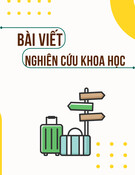


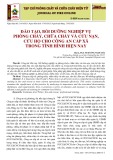
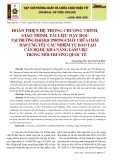


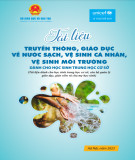
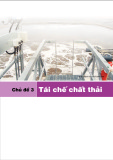
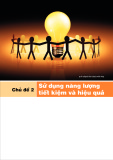
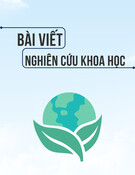
![Tài liệu Vi sinh vật môi trường [Mới nhất]](https://cdn.tailieu.vn/images/document/thumbnail/2025/20251123/ngkimxuyen/135x160/21891763953413.jpg)
![Sổ tay truyền thông Phân loại chất thải rắn sinh hoạt trên địa bàn tỉnh Quảng Nam [Chuẩn nhất]](https://cdn.tailieu.vn/images/document/thumbnail/2025/20251114/kimphuong1001/135x160/1701763094001.jpg)
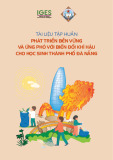
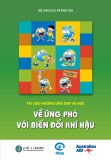
![Quản lý chất thải nguy hại: Sổ tay Môi trường [Chuẩn nhất]](https://cdn.tailieu.vn/images/document/thumbnail/2025/20251029/kimphuong1001/135x160/9011761720170.jpg)

